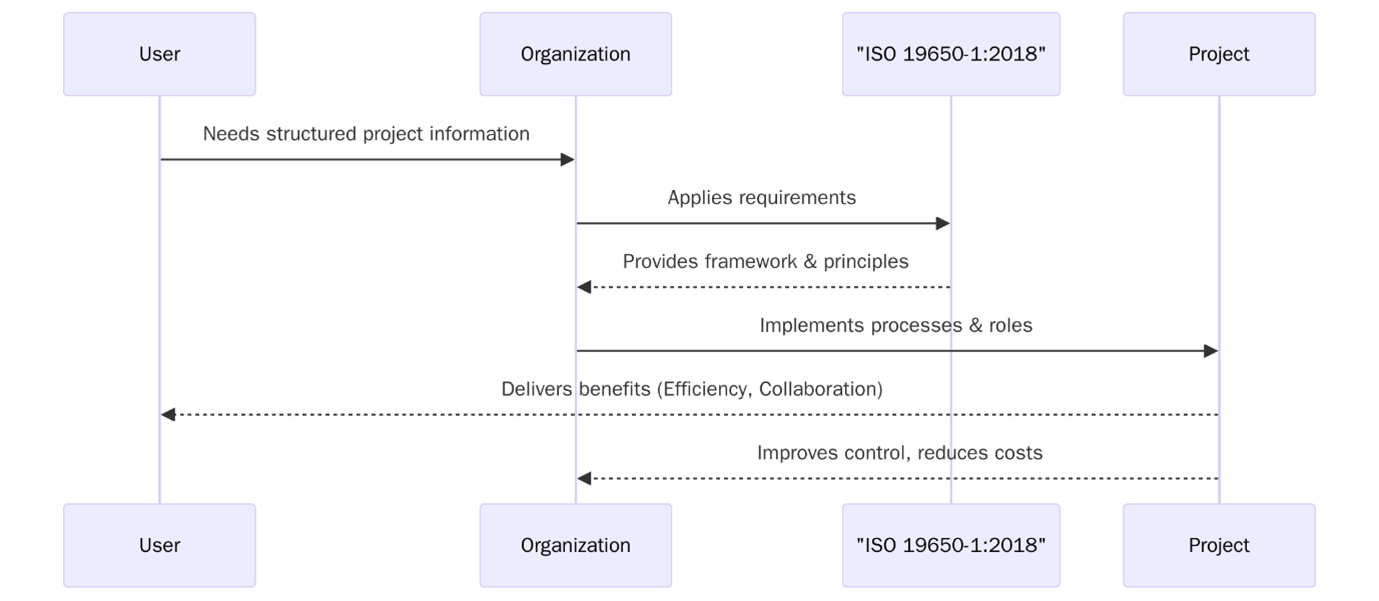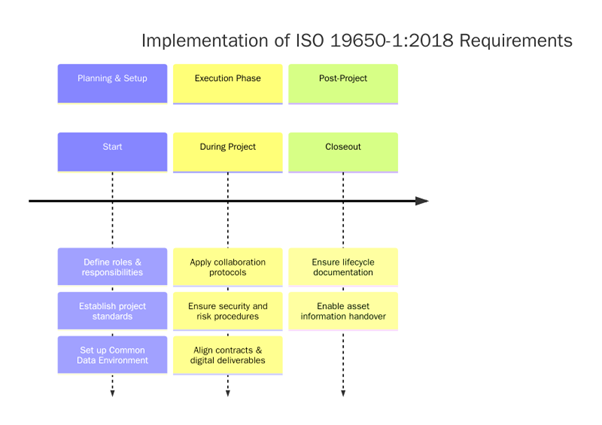ISO 19650-1:2018 – Organization and Digitization of Information About Buildings and Civil Engineering Works, Including Building Information Modelling (BIM) — Information Management Using Building Information Modelling
ISO 19650 is a multi-part international standard that provides a comprehensive framework for managing information over the entire life cycle of built assets using Building Information Modelling (BIM). Rooted in the UK’s BS 1192 and PAS 1192, this series supports improved collaboration, data organization, and risk reduction in construction and infrastructure projects worldwide.

The standard is designed for application across building and civil engineering sectors, enabling organizations to improve efficiency, reduce costs, and enhance decision-making through better data and information management practices.
To implement ISO 19650 in your construction projects or digital asset management, contact support@pacificcert.com.
Scope and Structure of ISO 19650
ISO 19650 applies to:
- Public and private sector construction projects
- Asset managers and facility operators
- Contractors, designers, and consultants involved in BIM
The standard is applicable across the life cycle of assets — from planning and design to operation and maintenance — and supports consistent information exchange among stakeholders.
ISO 19650-1:2018 — Concepts and Principles
This foundational part defines the concepts, principles, and terminology needed to establish an effective information management framework using BIM. It outlines:
- The structure and responsibilities of information delivery teams
- The role of the appointing party (e.g., client or asset owner)
- The information delivery cycle
- Use of Common Data Environments (CDEs) and information containers
It serves as the baseline for all other ISO 19650 parts.
ISO 19650-2:2018 — Delivery Phase of the Assets
ISO 19650-2 provides requirements for information management during the delivery phase of a project (i.e., design and construction). Key elements include:
- Defining Exchange Information Requirements (EIRs)
- Appointing Information Managers
- Setting up and managing a Common Data Environment
- Establishing information standards and delivery plans
This part ensures that accurate and usable information is delivered at each project milestone.
ISO 19650-3:2020 — Operational Phase of the Assets
This section addresses the operational and maintenance phases after construction is complete. It ensures that:
- Information remains structured and accessible throughout the asset’s life
- Asset information requirements (AIR) are maintained
- Facilities management teams have real-time access to updated documentation
- Performance can be monitored using reliable and verifiable data
This is essential for improving long-term asset value and efficiency.
ISO 19650-4:2022 — Information Exchange
This newly introduced part provides detailed guidance on structured information exchanges. It ensures:
- Proper verification and validation processes
- Data consistency during information exchange
- Effective use of digital information across multiple systems
It is especially useful for multidisciplinary teams working across organizations.
ISO 19650-5:2020 — Security-Minded Approach
This part adds a layer of security and resilience to the information management process. It includes:
- Guidelines for handling sensitive information
- Access control for digital models and data
- Managing cyber and physical security risks in digital construction environments
This is critical for national infrastructure and defense-related projects.
Certification and Implementation Process
- Readiness Assessment and Gap Analysis:
- Compare current practices with ISO 19650 requirements
- Identify gaps in data structures, documentation, and team roles
- Planning and Strategy Development:
- Develop a BIM execution plan
- Establish roles such as the Information Manager and appointing party responsibilities
- Establishing Information Requirements:
- Define EIRs, AIRs, and project-specific information delivery milestones
- Common Data Environment Setup:
- Deploy a secure, shared platform for managing files, models, and communication
- Training and Team Development:
- Upskill staff on information standards, BIM modeling, and data security
- Internal Evaluation and Trial Runs:
- Conduct dry-runs of model delivery, approvals, and review workflows
- External Audit or Compliance Review (Optional):
- While ISO 19650 itself is not a certifiable standard, organizations can opt for third-party assessments aligned with ISO 9001, ISO 27001, and ISO 19650 best practices
To get started, contact support@pacificcert.com for a personalized implementation guide.
Documentation Required for ISO 19650 Implementation
- BIM Execution Plan (BEP)
- Exchange Information Requirements (EIR)
- Asset Information Requirements (AIR)
- Project Information Model (PIM) and Asset Information Model (AIM)
- Information Delivery Plans (IDP)
- CDE Access Protocols and Versioning Procedures
- Security Risk Assessments (ISO 19650-5)
Get assistance with documentation templates at support@pacificcert.com.
Eligibility for ISO 19650 Implementation
Organizations involved in the planning, design, construction, or management of built assets can benefit from ISO 19650. These include:
- Architecture, Engineering, and Construction (AEC) firms
- Public and private infrastructure developers
- Government and defense projects
- Facility management companies
Check your eligibility with a consultation at support@pacificcert.com.
Estimated Costs and Implementation Timeline
Costs depend on project scale, team size, and digital readiness. Request a custom quote from support@pacificcert.com.
Timeline:
- Gap Analysis and Planning: 3-4 weeks
- Information Model Design and Documentation: 1-2 months
- CDE Setup and Pilot Testing: 2-4 weeks
- Full Implementation and Audit: 1 month
Total Estimated Duration: 3–5 months
Requirements of ISO 19650 Implementation
To align with ISO 19650, organizations must:

- Establish structured information workflows for all asset life cycle stages
- Define clear roles and responsibilities for information management
- Use naming conventions, metadata, and file version controls
- Protect sensitive data with a security-minded approach
- Conduct regular information reviews and approvals
- Maintain consistency across disciplines using a shared CDE
Need support aligning your team with these requirements? Contact support@pacificcert.com.
Benefits of ISO 19650 Series Implementation
- Efficient Project Delivery: Improved coordination and reduced rework
- Lifecycle Asset Management: Better facilities management and cost control
- Enhanced Collaboration: Standardized information exchange across disciplines
- Reduced Risk and Cost: Fewer errors, delays, and disputes from inconsistent data
- Regulatory Alignment: Easier compliance with BIM mandates and public procurement
- Digital Transformation: Boosts innovation and productivity in the AEC sector

Harness these benefits with expert support, contact support@pacificcert.com.
Trends and Global Relevance
Governments and infrastructure investors are increasingly requiring BIM-based project delivery. ISO 19650 supports:
- National digital construction initiatives (UK BIM Mandate, EU BIM standards)
- Public procurement eligibility
- Cross-border project collaboration
- Smart city and digital twin development
ISO 19650 is rapidly becoming a global reference for digital project delivery.
How Pacific Certifications Can Help
We offer tailored support to organizations adopting ISO 19650, including:
- Gap assessments and implementation planning
- BIM Execution Plan development
- CDE deployment support and audit preparation
- Training for information managers and delivery teams
- Alignment with ISO 9001, ISO 27001, and digital construction practices
Start your ISO 19650 implementation journey by contacting support@pacificcert.com.
Frequently Asked Questions (FAQs)
Is ISO 19650 certifiable?
No, but third-party assessments and internal audits can validate your compliance.
How is ISO 19650 different from ISO 16739 (IFC)?
ISO 19650 focuses on managing information workflows; ISO 16739 defines BIM data format (IFC).
Do I need all parts of ISO 19650?
Yes, if you want full lifecycle management. Start with Part 1 and 2, then expand to 3–5 as needed.
What software supports ISO 19650 workflows?
Common platforms include Autodesk BIM 360, Trimble Connect, Bentley ProjectWise, and Dalux.
Can small firms adopt ISO 19650?
Yes, it is scalable. Smaller firms can begin with simplified BEPs and gradually adopt a full framework.
Suggested Certifications –
Read More at – Pacific Certifications Blogs






